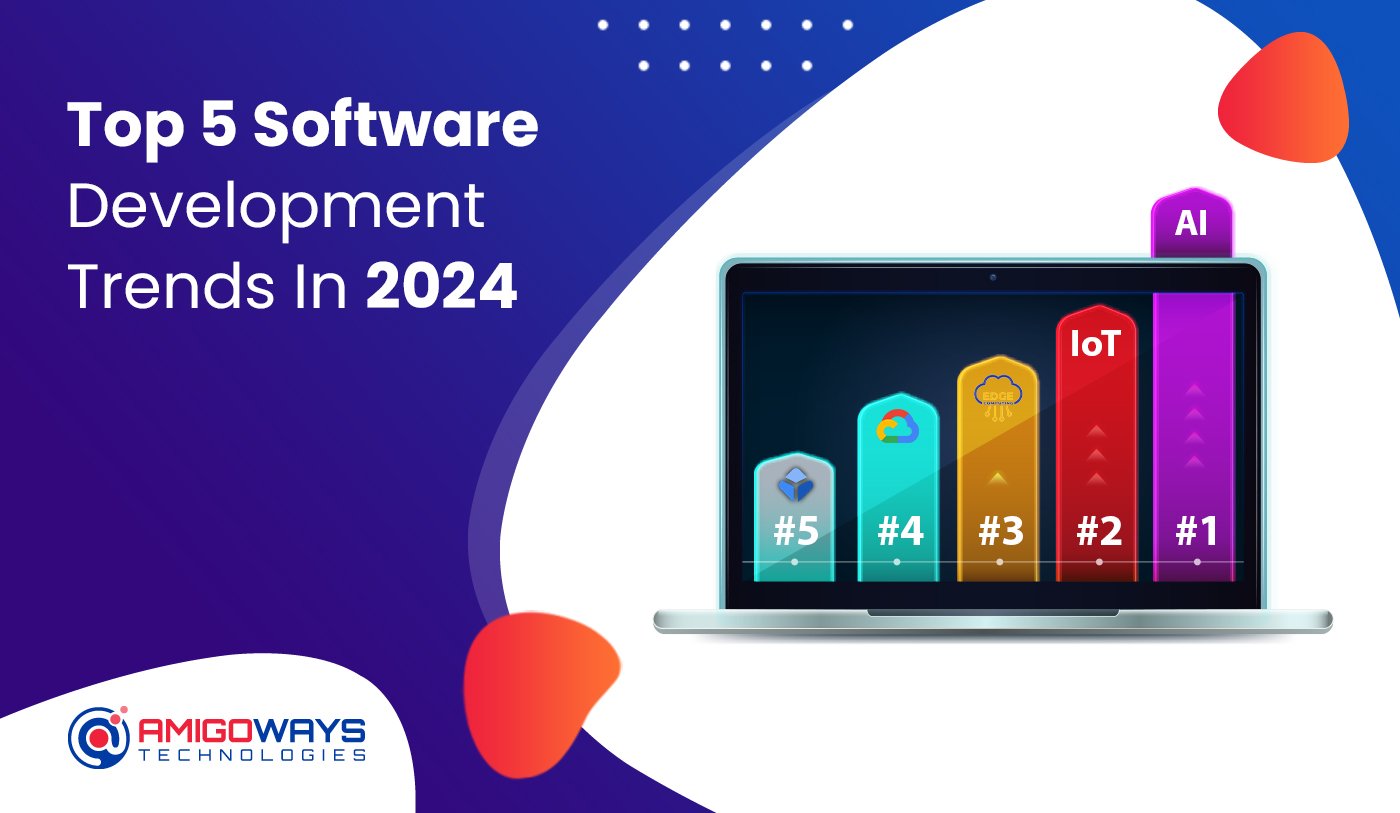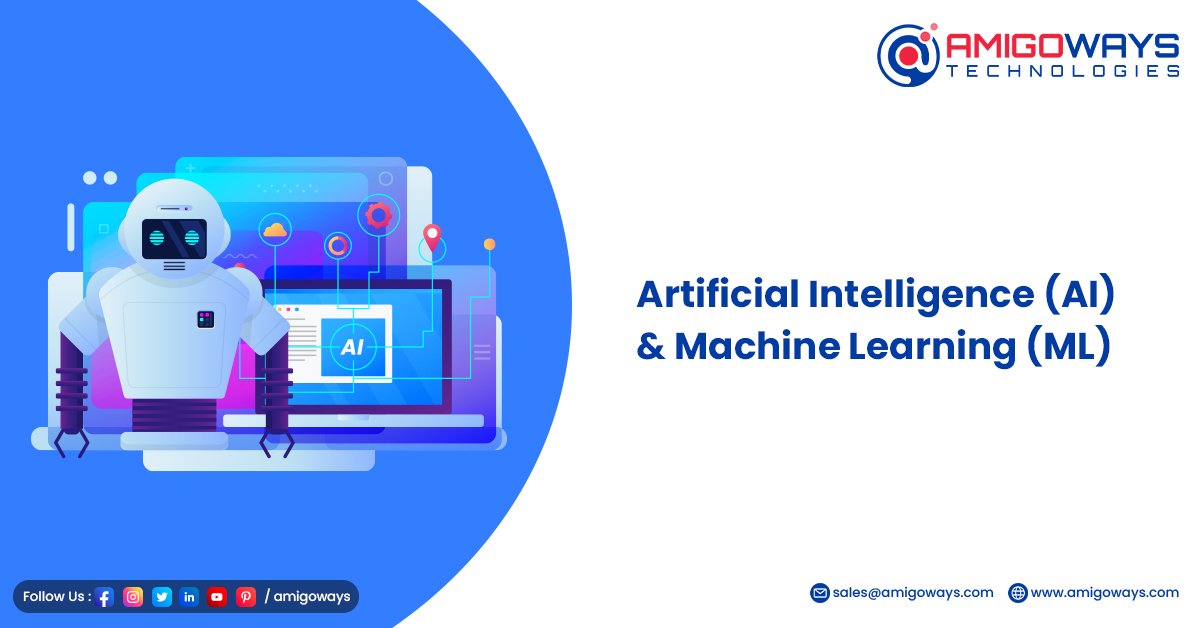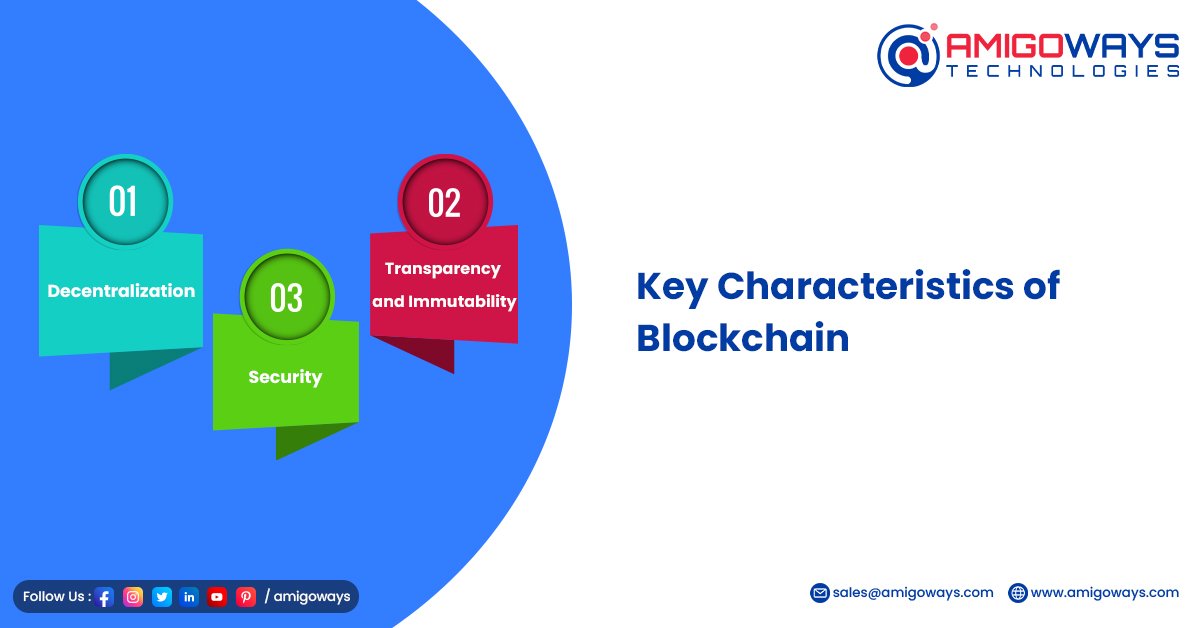Top 5 Software Development Trends In 2024 - Amigoways
- Get link
- X
- Other Apps

Software development trends refer to the patterns, practices, and technologies that are shaping and influencing the field of software development. These trends often emerge as a response to evolving user needs, technological advancements, and changing market demands. Staying aware of and adopting these trends can help software developers and organizations stay competitive and deliver innovative solutions.
Software development trends encompass a wide range of areas, including programming languages, development methodologies, tools, frameworks, and technologies. These trends often reflect the industry’s pursuit of more efficient, scalable, secure, and user-centric software solutions.
Some Common Software Development Trends Include
1. Artificial Intelligence (AI) & Machine Learning (ML)
Artificial Intelligence (AI) and Machine Learning (ML) are transformative technologies that enable software systems to exhibit intelligent behavior and improve their performance over time. AI focuses on creating machines that can simulate human intelligence and perform tasks that typically require human cognition. ML, on the other hand, is a subset of AI that involves training algorithms to learn from data and make predictions or take actions without being explicitly programmed.
AI and ML have numerous applications across various industries. Natural Language Processing (NLP) allows computers to understand, interpret, and generate human language, enabling applications such as chatbots, virtual assistants, and language translation. Computer Vision enables machines to perceive and interpret visual information, enabling applications like object recognition, image and video analysis, and autonomous vehicles.
ML algorithms are trained on large datasets to recognize patterns, make predictions, and automate decision-making. They are used in areas such as predictive analytics, fraud detection, recommendation systems, and personalized marketing. Deep Learning, a subfield of ML, uses neural networks with multiple layers to process complex data and extract high-level features, achieving state-of-the-art results in image and speech recognition, natural language processing, and autonomous systems.

The potential impact of AI and ML is vast. They can enhance efficiency, productivity, and accuracy in various industries, including healthcare (diagnosis and personalized medicine), finance (risk assessment and algorithmic trading), manufacturing (predictive maintenance and quality control), and transportation (autonomous vehicles and route optimization). They also raise ethical considerations regarding data privacy, bias in algorithms, and the ethical use of AI.
As AI and ML technologies continue to advance, developers have access to powerful frameworks and libraries that simplify the development and deployment of AI-powered applications. These technologies offer exciting opportunities to create intelligent systems that can learn, adapt, and make decisions, leading to advancements in automation, personalization, and problem-solving across numerous domains.
2. Internet Of Things (IoT)
The Internet of Things (IoT) refers to a network of interconnected physical devices, vehicles, appliances, and other objects that are embedded with sensors, software, and connectivity capabilities. These devices can collect and exchange data, interact with each other, and perform tasks without human intervention.
The key concept behind IoT is the ability of these devices to connect and communicate with each other through the internet, enabling the exchange of data and the execution of actions. This connectivity allows for the seamless integration of the physical world with the digital realm, creating a network of smart, interconnected devices.
IoT has applications in various domains, including smart homes, healthcare, manufacturing, transportation, agriculture, and more. In smart homes, IoT devices like smart thermostats, lighting systems, and security cameras can be controlled and monitored remotely through smartphones or voice assistants. In healthcare, IoT enables remote patient monitoring, wearable devices for tracking vital signs, and smart medical equipment. In manufacturing, IoT can optimize processes through real-time monitoring of machinery, predictive maintenance, and supply chain optimization. In agriculture, IoT can be used for precision farming, monitoring soil conditions, and automated irrigation systems.
.jpg)
IoT generates massive amounts of data that can be analyzed and utilized for insights and decision-making. This data can be used to optimize operations, improve efficiency, and enable data-driven decision-making. However, the collection and management of IoT data also raise concerns about data privacy, security, and the ethical use of personal information.
As IoT technology continues to advance, we can expect the expansion of IoT ecosystems, the development of more sophisticated and interconnected devices, and the integration of AI and machine learning for data analysis and automation. The growth of IoT will lead to increased connectivity, improved efficiency, and new opportunities for innovation in various industries, ultimately shaping the way we interact with the world around us.
3. Edge Computing
Edge computing is a distributed computing paradigm that brings data processing and storage closer to the edge devices or sensors, rather than relying solely on centralized cloud infrastructure. In edge computing, computation and data storage occur at or near the source of data generation, reducing the need for data to travel to distant data centers or the cloud for processing.
The main motivation behind edge computing is to overcome the limitations of traditional cloud computing, such as latency, bandwidth constraints, and privacy concerns. By processing data closer to the edge, edge computing reduces the time it takes for data to travel, resulting in lower latency and faster response times. This is particularly crucial for applications that require real-time or near-real-time processing, such as autonomous vehicles, industrial automation, and augmented reality.
Edge computing is closely associated with the Internet of Things (IoT) because it addresses the needs of processing the massive amounts of data generated by IoT devices. Instead of sending all IoT data to the cloud, edge computing enables local processing and filtering of data at the edge devices themselves. This reduces the volume of data sent to the cloud, minimizes bandwidth requirements, and conserves network resources.
Edge computing also offers enhanced data privacy and security. Since sensitive data is processed locally at the edge, it reduces the risk of data breaches and unauthorized access. This is particularly important in sectors like healthcare and finance, where data privacy and security are paramount.
Furthermore, edge computing allows for offline or intermittent connectivity scenarios. Edge devices can continue to operate and process data even when there is limited or no internet connection. This makes edge computing suitable for remote or disconnected environments, such as rural areas or industrial facilities.
Overall, edge computing brings computation, storage, and data processing capabilities closer to the edge devices, enabling faster response times, reduced latency, improved data privacy, and enhanced offline capabilities. It complements cloud computing by providing a decentralized and distributed approach to data processing, catering to the specific needs of IoT, real-time applications, and scenarios where low latency and privacy are critical.
4. Cloud Computing
Cloud computing refers to the delivery of on-demand computing resources over the internet. It involves the provision of virtualized computing infrastructure, such as servers, storage, databases, networking, and software, that can be accessed and used remotely by users and organizations.
In cloud computing, instead of relying on physical servers and infrastructure located on-premises, users can leverage the services and resources offered by cloud service providers. These providers maintain and manage the underlying infrastructure, allowing users to focus on their applications and data without the need for hardware provisioning, maintenance, or management.
Cloud computing offers several key advantages. First, it provides scalability and flexibility, allowing users to easily scale their resources up or down based on their needs. This ensures efficient resource utilization and cost savings since users only pay for the resources they consume.
Second, cloud computing offers high availability and reliability. Cloud service providers typically have redundant infrastructure and data centers, ensuring that applications and data remain accessible even in the event of hardware failures or outages.
Third, cloud computing enables collaboration and remote access. Users can access their applications and data from anywhere with an internet connection, facilitating remote work and collaboration among teams.
Cloud Computing Is Categorized Into Three Main Service Models
- Infrastructure as a Service (IaaS): This model provides virtualized computing resources, such as virtual machines, storage, and networks, allowing users to build and manage their own infrastructure.
- Platform as a Service (PaaS): PaaS offers a complete development and deployment environment, including infrastructure, runtime environment, and development tools. It allows users to focus on application development without worrying about infrastructure management.
- Software as a Service (SaaS): SaaS provides fully functional applications that are accessible over the internet. Users can utilize these applications without the need for installation or management, as everything is handled by the service provider.
Cloud computing has transformed the way organizations and individuals consume and deliver computing resources. It has become a fundamental component of modern software development, offering scalability, flexibility, cost-efficiency, and simplified infrastructure management.

5. Blockchain
Blockchain is a decentralized and distributed ledger technology that enables secure and transparent recording and verification of transactions across multiple parties. It operates as a chain of blocks, where each block contains a list of transactions, and each block is linked to the previous one, creating an immutable and transparent record of all transactions.
The Key Characteristics Of Blockchain Include
- Decentralization: Blockchain operates on a decentralized network, where multiple participants or nodes maintain a copy of the entire blockchain. This decentralized nature eliminates the need for a central authority or intermediary, making transactions more peer-to-peer.
- Transparency & Immutability: Once a transaction is recorded on the blockchain, it becomes virtually impossible to alter or tamper with. This immutability ensures the integrity of the data and provides transparency, as all participants can view and verify the transactions on the blockchain.
- Security: Blockchain uses cryptographic algorithms to secure transactions and ensure data integrity. The distributed nature of blockchain makes it resistant to hacking or malicious attacks, as altering a single block would require tampering with the entire chain across multiple nodes.
Blockchain technology originated with the invention of Bitcoin, the first decentralized cryptocurrency. However, its applications have expanded beyond cryptocurrencies. Blockchain has the potential to transform various industries, including finance, supply chain management, healthcare, real estate, and more.
In finance, blockchain enables faster and more secure transactions, eliminates intermediaries, and facilitates cross-border payments. Supply chain management can benefit from blockchain by providing transparency and traceability, enabling efficient tracking of products and verifying their authenticity. In healthcare, blockchain can enhance data security, interoperability, and patient privacy by securely storing and sharing medical records.
Smart contracts, which are self-executing contracts with predefined rules encoded on the blockchain, enable automated and trustworthy execution of agreements without the need for intermediaries. This feature opens up possibilities for applications in areas such as insurance, legal contracts, and decentralized applications (DApps).
While blockchain technology offers several advantages, it also poses challenges such as scalability, energy consumption, and regulatory considerations. Nonetheless, its potential to provide secure, transparent, and decentralized solutions makes blockchain an area of ongoing innovation and exploration in various sectors.
One of the best software development companies who can offer all the above mentioned services is Amigoways Technologies. Here we do what we love and deliver the best software and solution for you in the market. Be competitive and part of us.
This article is originally published by 
Tag: best software development company, IT company, software development trends, ai, blockchain, edge computing, cloud computing, machine learning
- Get link
- X
- Other Apps







Comments
Post a Comment